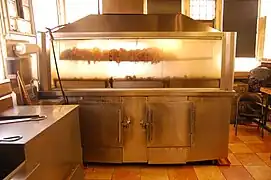
| Part of a series on |
| American cuisine |
|---|
 |
Chicago-style barbecue is a regional variation of barbecue from the American city of Chicago, Illinois. The style developed due to immigration from other countries and parts of the United States. It is known for the invention of the aquarium smoker and the prominence of rib tips and hot links.
History
The earliest barbecue restaurants in Chicago were established by African Americans who moved to Chicago from the Southern United States during both phases of the Great Migration from the south.[1][2] Between 1910 and 1970, the number of African-Americans in Chicago increased from 50,000 to 1,000,000.[3] The oldest currently operating barbecue restaurant in the region, Russell's Barbecue, was founded in Elmwood Park in 1930, although African-American barbecue traditions had probably reached the city even earlier. Other notable Chicago barbecue restaurants include Leon's Bar-B-Q and Lem's Bar-B-Q, the latter of which helped to popularize aquarium smokers. Italians and Greeks in Chicago also founded barbecue restaurants during the mid-20th century.[4] Eastern European immigrants in the North Side of Chicago further influenced the development of barbecue in the city, especially the popularity of sausage and boiled meat.[5]
Many historic South Side barbecue establishments serve customers through a bulletproof glass divider.[6][7][8] The popularity of Chicago-style barbecue has declined in 21st-century Chicago due to the growing number of Texas-style barbecue restaurants.[9][2]
Styles

South Side and West Side

In 1954, the aquarium smoker, which is named after its resemblance to a fish tank, was invented in Chicago.[5] These smokers allowed smoked meats to be prepared indoors during the winter.[8] They are fully enclosed except for a metal chimney that vents the smoke outside, allowing for fully indoor cooking.[10] The chimney is fitted with smoke scrubbers to minimize pollution.[11] Glass panels on the sides of the smoker allow the cook to see inside. The wood for smoking the meat is typically placed below, allowing it to cook quickly.[2] The temperature of the smoker is controlled by spraying the fire with a garden hose if it gets too hot.[8] This style of smoker became common in the South Side and West Side of Chicago. Hardwoods, like hickory and oak, are usually used in those neighborhoods.[5] Charcoal may also be used as fuel.[7] A thin, tomato-based barbecue sauce is used in South Side and West Side barbecue.[5] Some Chicago restaurants also serve mild sauce, which can include various ingredients such as barbecue sauce and ketchup.[12]
Rib tips, the cartilaginous end pieces left from butchering St. Louis–style ribs, became popular in the South Side of Chicago because of their low cost. The gelatinousness of the rib gives it a chewy exterior when cooked. The establishment of the meatpacking industry in Chicago, especially the Union Stock Yards, also contributed to the choice of cuts prepared in the South Side, where off-cuts of meat were cheaply available.[5][2] Early African-American-owned barbecue restaurants are credited with the popularization of this dish.[4] Delta-style Chicago ribs are smoked in aquarium smokers. A distinctive style of boiled ribs developed in the Eastern European community, which frequently boiled meats.[11]
Hot links are commonly served in combination with rib tips, as "tip-link" barbecue. This combination is typically served with French fries and sliced white bread.[8][2] Fried chicken with barbecue sauce, called "barbecue chicken" in Chicago, is also frequently served by South Side restaurants like Harold's Chicken Shack.[13]
North Side
In the North Side, barbecue restaurants typically use rotisserie smokers and local woods like applewood to prepare their meat. North Side barbecue sauces are also tomato-based but are typically thicker than South Side sauces. North Side restaurants typically focused on more expensive cuts of meat, such as pork butt and brisket.[5]
References
- ↑ "The Food Guy: Barbecue in Chicago and Black History Month". NBC Chicago. February 3, 2023. Retrieved July 25, 2023.
- 1 2 3 4 5 Owens, Hunter (August 3, 2016). "Welcome to America's Unsung Barbecue City: Chicago". Saveur. Retrieved July 25, 2023.
- ↑ "Rib Tips, Hot Links, and the Mississippi Roots of Chicago Barbecue | Southern Foodways Alliance - Southern Foodways Alliance". September 14, 2022. Retrieved July 26, 2023.
- 1 2 Block, Daniel R.; Rosing, Howard B. (September 3, 2015). Chicago: A Food Biography. Rowman & Littlefield. pp. 72–74. ISBN 978-1-4422-2727-9.
- 1 2 3 4 5 6 Freeman, Sarah (June 15, 2016). "What Is Chicago-Style Barbecue, Anyway?". Eater Chicago. Retrieved July 25, 2023.
- ↑ "The Best Barbecue in Every State". Food & Wine. Retrieved July 27, 2023.
- 1 2 "Chicago-Style BBQ Tour: Looking for the Best with Hecky Powell". Chicago Magazine. Retrieved July 27, 2023.
- 1 2 3 4 Pang, Kevin (February 8, 2018). "Chicago Is A City Divided By Barbecue". Saveur. Retrieved July 25, 2023.
- ↑ Kindelsperger, Nick (September 26, 2022). "Don't Forget South Side barbecue in Chicago as Texas-Style Ascends". Chicago Tribune. Retrieved July 25, 2023.
- ↑ Goodrich, Theresa (October 25, 2016). "Aquarium Smokers & Pitmaster Legends: The Great Chicago BBQ Tour - Your Chicago Guide". Retrieved July 25, 2023.
- 1 2 Coppieters, Kris (October 4, 2017). "The Story Of Chicago Barbecue And Guide To Chicago BBQ Restaurants". Meathead's AmazingRibs.com. Retrieved July 25, 2023.
- ↑ Stein, Isaac. "It's in the air: Lem's smokes up BBQ and sauce right". Chicago Maroon. Retrieved July 27, 2023.
- ↑ Miller, Adrian (April 5, 2021). Black Smoke: African Americans and the United States of Barbecue. UNC Press Books. p. 156. ISBN 978-1-4696-6281-7.
